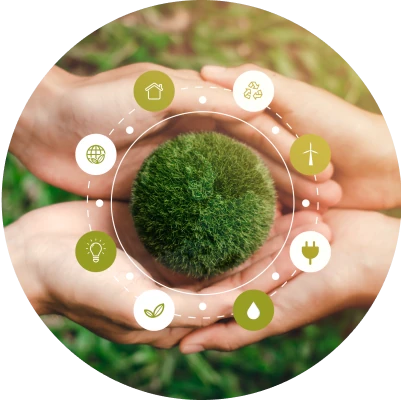Sustainability Framework and Goals
By integrating sustainable development concepts into the company's business plan, the company has adjusted its business strategy and shifted towards sustainability-oriented management.
This approach aims to meet the needs of stakeholders and effectively address global changes and emerging risks. Furthermore, the company strives to become a well-rounded organization that creates opportunities and benefits for all stakeholders, fostering business and socio-economic growth while coexisting harmoniously with surrounding communities. This is based on the commitment to preserving natural resources and the environment. Therefore, the company has established the following key strategies for sustainable business operations:
Strategy and Framework for Sustainability Development

Strategy 1
Building Business Stability with Ethics and Governance

Strategy 2
Reducing Environmental Impact and Enhancing Resource Efficiency

Strategy 3
Creating Shared Value Between the Organization and Social
Goals
-
1Achieve zero business ethics violations every year.
-
2Maintain zero tolerance for corruption.
-
3Resolve complaints within the specified timeframe.
Implementation Approach
-
1Establish clear and transparent operational guidelines to build trust among stakeholders.
-
2Enhance risk analysis processes and leverage technology to improve decision-making efficiency.
-
3Collaborate with business partners to develop ethical and sustainability standards across all stages.
-
4Ensure effective corporate governance with integrity, ethics, and fairness.
-
5Provide accessible complaint channels and efficient grievance management mechanisms.
-
6Develop strategies for managing non-performing loans that balance profitability with economic and social support.

Goals
-
1Achieve carbon neutrality by 2050.
-
2Commit to continuously reducing annual greenhouse gas emissions by 3%.
-
3Ensure zero violations of environmental and social regulations by employees and business partners.
Implementation Approach
-
1Enhance resilience to climate change, reduce greenhouse gas emissions, and increase carbon absorption across various activities.
-
2Prevent and mitigate negative impacts from the company’s operations and those of its business partners.
-
3Protect and restore natural resources both within and outside the company.
-
4Transparently disclose policies and management practices regarding natural resources and environmental sustainability.

Goals
-
1Ensure zero human rights violations across the value chain.
-
2Maintain an average of at least 6 hours of training per employee per year.
-
3Achieve zero Lost Time Injury Frequency Rate (Zero LTIFR).
-
4Engage with communities within a 10-kilometer radius of the headquarters through corporate community and social development activities.
Implementation Approach
-
1Conduct comprehensive human rights due diligence across the supply chain.
-
2Develop employees’ knowledge and social skills while promoting career advancement.
-
3Enhance safety and security for all key stakeholders across the supply chain.
-
4Support initiatives and activities that foster collaboration among stakeholders to improve the quality of life in nearby communities and society as a whole.

